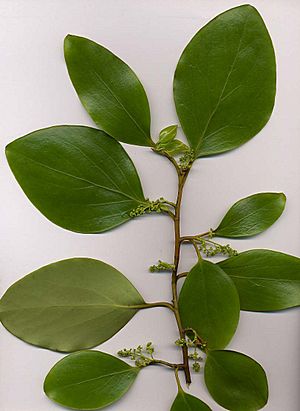Kapuka facts for kids
Quick facts for kids Kapuka, papauma |
|
|---|---|
 |
|
| Kapuka leaves and flowers | |
| Scientific classification | |
| Genus: |
Griselinia
|
| Species: |
littoralis
|
Griselinia littoralis, also known as kapuka or New Zealand broadleaf, is a fast-growing evergreen tree. It is native to New Zealand. This tree is popular for its tough nature and ability to grow well in many places.
Contents
What Kapuka Looks Like
Kapuka is a strong evergreen shrub that can grow up to 10 to 15 metres tall. It has a rounded shape with lots of leaves. The leaves are leathery and glossy, meaning they are shiny. They are yellow-green on top and a lighter, duller green underneath. Each leaf is about 6 to 14 cm long and oval-shaped with smooth edges.
This tree also grows small, greenish flowers and dark berries. The flowers appear from late spring to mid-summer. The berries are small, about 6-7 mm long, and ripen from autumn to winter.
Where Kapuka Grows in the World
Kapuka is originally from New Zealand. However, people now grow it in other parts of the world too. It is very popular in places with mild ocean climates, like the south coast of Great Britain and the Faroe Islands. This is because Kapuka can handle salt from sea winds very well.
The scientific name littoralis means "growing by the sea." This fits well because in New Zealand, you can find many Kapuka trees near the coast. It is often planted as a screen to protect against strong winds.
Kapuka in New Zealand
You can find Kapuka all over New Zealand, from sea level up to 900 metres high. It grows from the far north down to Stewart Island. It is most common in coastal areas because it is a very tough plant.
Kapuka grows in many different environments. You can find it in lowlands, on high hills, in forests, or in shrub lands. It is more common in the South Island than the North Island. In the North Island, it usually grows at higher altitudes.
Kapuka's Habitat
Kapuka is native to New Zealand and grows throughout the country. It especially likes coastal areas because it can handle sea breezes and strong winds. While it can survive in many conditions, Kapuka prefers certain habitats.
It likes soil that drains water well, like light loamy soil. This plant can handle cold temperatures down to about -10°C and warm temperatures up to 35°C. Kapuka needs full sun or partly shaded areas to grow best. Like many native New Zealand plants, it can survive with very few nutrients. However, it will grow even better in areas with more nutrients. It also prefers places with a lot of rainfall for good growth.
In very moist climates, Kapuka might even grow as an epiphyte. This means it grows on another plant, but its roots still reach deep into the ground to get water and nutrients.
Kapuka's Life Cycle
Kapuka flowers in spring, producing small, greenish-yellow flowers. These flowers grow on small branches called panicles, which are about 2 to 5 cm long. Each panicle can have 50 to 100 tiny flowers. Each flower is about 3–4 mm wide and has five sepals and stamens, but no petals.
After flowering, small blackish berries form. This happens if male and female Kapuka trees are close enough for pollination to occur. Birds help spread the seeds around. This stops too many young plants from growing in the same spot, so they don't compete for water, sunlight, and nutrients. It also helps Kapuka spread to new areas. The seeds sprout when they fall to the ground, and new plants begin to grow. Kapuka trees can live for a long time, often over fifty years.
The flowers are very small and green. Male and female flowers grow on different trees. Wind and insects help carry pollen from one flower to another. The fruits stay green until they are ready to ripen and fall from the tree. The dark purple or black berries appear in mid-summer and ripen from autumn to winter.
Animals That Eat Kapuka
Animals like goats, deer, possums, and insects sometimes eat Kapuka leaves. Even though these animals graze on its leaves, Kapuka is usually a healthy and dense shrub. It can handle being eaten fairly well.
Other Interesting Facts About Kapuka
The bark of the Kapuka tree was traditionally used by the Māori as medicine. They used it to treat skin infections before modern medicines were available.
Kapuka is often used as a hedge or screen. It's a tough shrub that can be trimmed easily and looks good all year round with little care. It makes a great coastal hedge because it can resist strong winds, especially in harsh seaside environments.
In the UK, Griselinia littoralis and a special type called 'Variegata' have won an award called the Royal Horticultural Society's Award of Garden Merit.

